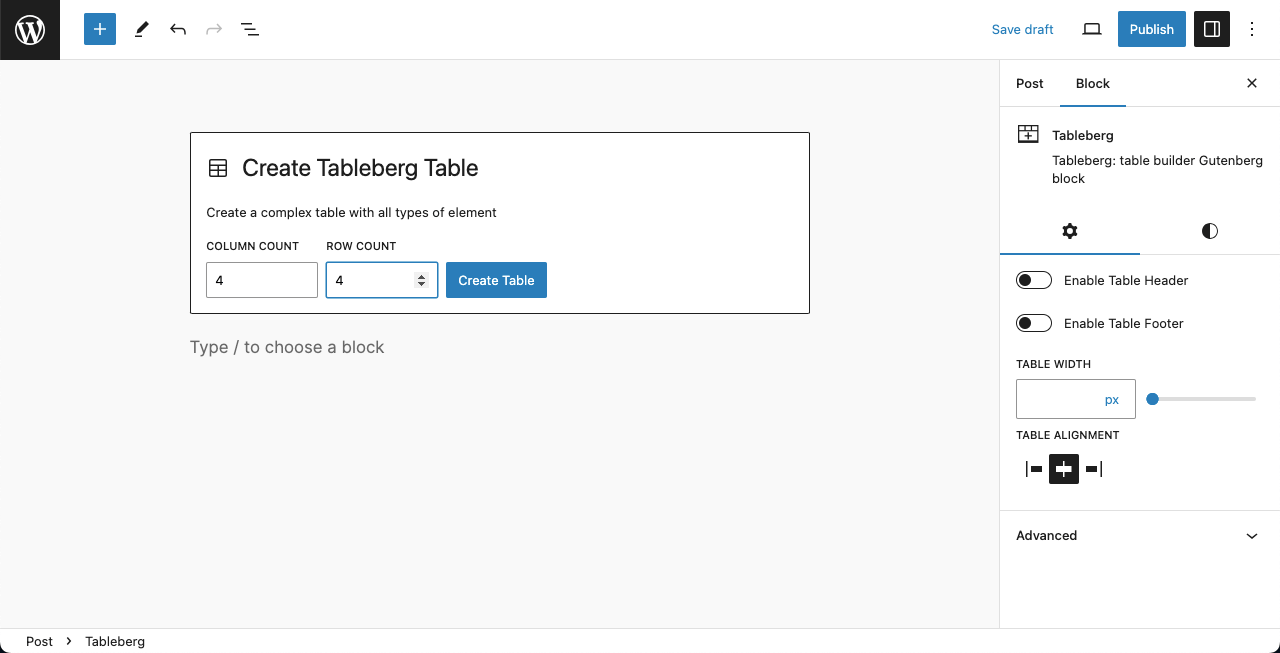Eine Tabelle in WordPress zu formatieren bedeutet, eine Tabelle so zu erstellen und zu gestalten, dass die Daten in der Tabelle bequem dargestellt und auf Webbeiträgen und Seiten angezeigt werden können. Es hilft Ihnen, die Klarheit und Lesbarkeit Ihrer Inhalte zu verbessern.
WordPress bietet einen integrierten Tabellenblock. Sie können mit diesem Block jedoch nur einfache Tabellen erstellen, da ihm zahlreiche erweiterte Funktionen fehlen. In diesem Fall können Sie den Tischberg Plugin, um Ihre Tabellen in WordPress richtig zu formatieren.
In diesem Blogbeitrag zeigen wir Ihnen Schritt für Schritt, wie Sie mit dem Tableberg-Plugin Tabellen in WordPress formatieren können.
Was gehört zur Formatierung einer Tabelle in WordPress?
Es gibt mehrere Schlüsselelemente bei der Formatierung einer Tabelle in WordPress. Sie sind:
- Zeilen & Spalten
- Umrandung (Farbe und Radius)
- Zellenrand und Füllung
- Ausrichtung
- Hintergrundfarbe
- Schriftart und Typografie
- Reaktionsfähigkeit
- Kopfzeile & Fußzeile
- Globaler Stil
- Hinzufügen von Bildern, Schaltflächen und Symbolen
Darüber hinaus gibt es noch viele andere Dinge, die Sie bei der Formatierung Ihrer Tabelle berücksichtigen können.
Formatierung von Tabellen in WordPress
Sie können alle oben genannten Formatierungen in WordPress mit dem Plugin Tableberg durchführen. Sehen wir uns an, wie das geht.
Hinweis: Der Standard-Tabellenblock bietet nicht viele Formatierungsmöglichkeiten. In diesem Tutorial werden wir die Tableberg-Plugin für die Formatierung einer WordPress-Tabelle.
1. Zeilen und Spalten
Wie beim Standard-Tabellenblock können Sie auch bei Tableberg die Anzahl der Zeilen und Spalten festlegen.

Auch hier gilt, wie beim Standard-Tabellenblock, Sie können Zeilen und Spalten einfügen/löschen vom Tisch.

2. Umrandung festlegen (Farbe und Radius)
Sie können die Tabelle einstellen die Farbe und die Breite des Rahmens, und Radiuswas mit dem Standardblock nicht möglich ist. Sie können sie beide für den innen und Außengrenzen.

3. Zellrand und Füllung
Sie können den Rand und die Auffüllung für Zellen in zwei Möglichkeiten – individuell und allgemein.
- Ränder und Abstände für einzelne Zellen festlegen
Setzen Sie den Cursor auf eine beliebige Zelle. Klicken Sie auf die Plus-Symbol (+) neben der Option Abmessungen. Hier werden Ihnen zwei Optionen angezeigt: Auffüllung und Rand.

Jetzt können Sie für die Zelle eine Auffüllung festlegen. Dies kann auch einige andere Zellen betreffen, aber nicht alle.

- Zellenrand und Füllung universell einstellen
Wählen Sie die gesamte Tabelle aus. Dann, zur Registerkarte "Stile" gehen.

Scrollen Sie auf der Registerkarte nach unten, bis Sie die Option Abmessungen finden. Unter dieser Option finden Sie die Optionen Zellauffüllung und Zellabstand. Mit diesen Optionen können Sie die Zellenauffüllung und -abstände universell einstellen.

4. Ausrichtung
Sie können die Ausrichtung für den Zellentext individuell anpassen.

Sie können auch die Ausrichtung der gesamten Tabelle anpassen. Wählen Sie dazu die Tabelle aus, indem Sie auf das Symbol Tableberg klicken. Wählen Sie dann die Option Ausrichtung.

5. Hintergrundfarbe
Wählen Sie die Tabelle. Land auf dem Registerkarte "Stile. Sie erhalten die Farboption. Sie können den Hintergrund für die ungeraden Zeilen, die geraden Zeilen, den Tabellenkopf und die Fußzeile separat auswählen.

Tableberg verfügt auch über einige erweiterte Funktionen. Sie können die Hintergrundfarbe der Zelle, der Zeile und der Spalte individuell einstellen.

6. Schriftart und Typografie
Mit der Standardoption des Plugins können Sie die Typografieeinstellungen konfigurieren, die Schriftart, Aussehen, Zeilenhöhe, Buchstabenabstand, Dekoration, Groß- und Kleinschreibung usw. umfassen.

Lernen Sie wie man eine Produktspezifikationstabelle in WordPress erstellt.
7. Reaktionsfähigkeit
Mit Tableberg können Sie Ihre Tabelle perfekt responsiv gestalten, damit sie auf allen Geräten, einschließlich Desktop, Tablet und Handy, gut aussieht.

8. Kopfzeile & Fußzeile
Obwohl wir normalerweise keine Kopf- und Fußzeilen zu unseren täglichen Tabellen hinzufügen, können Sie sie mit dem Tableberg-Plugin leicht hinzufügen. Sie finden diese Option im Plugin.

9. Global Style
Ein globaler Stil bezieht sich auf eine einheitliche Reihe von Designs, die auf die gesamte Tabelle angewendet werden. Mit dem Tableberg-Plugin können Sie den globalen Schriftstil konfigurieren, der die Schriftfarbe, die Verbindungsfarbe und die Schriftgröße umfasst.

10. Hinzufügen von Bildern, Schaltflächen und Symbolen
Genau wie der Gutenberg-Block-Editor ermöglicht das Tableberg-Plugin das Hinzufügen verschiedener Inhaltstypen wie Bilder, Schaltflächen, Symbole und Bänder zu Ihren Tabellenzellen unter Verwendung entsprechender Blöcke. Danach können Sie sie wie jeden anderen Block stilisieren.

Erkunden Sie wie man eine Vergleichstabelle in WordPress erstellt.
Schlussfolgerung
Vor Jahren musste man sich bei der Gestaltung von Tabellen auf Webseiten noch sehr auf benutzerdefinierte CSS- und HTML-Codes verlassen. Aber heute, mit der Tischberg Plugin können Sie dies auf einfache Weise tun, ohne dass Sie irgendeinen Code eingeben müssen.
Tableberg hat bereits viele aufregende Funktionen veröffentlicht und viele weitere Funktionen sind noch in Vorbereitung. Sehr bald werden Sie es als eine One-Stop-Lösung für alles, was Sie auf einem Tisch brauchen, bekommen. Holen Sie sich das Plugin also noch heute und haben Sie eine wunderbare Erfahrung vor sich.



